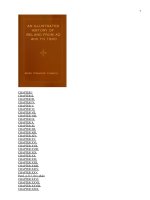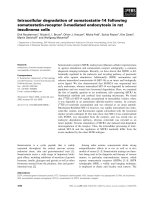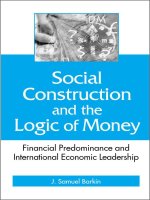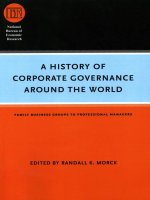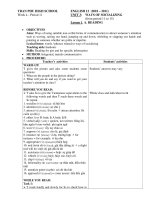university of wales press a history of money from ancient times to present day feb 2003
Bạn đang xem bản rút gọn của tài liệu. Xem và tải ngay bản đầy đủ của tài liệu tại đây (4.72 MB, 741 trang )
A History of Money
From Ancient Times to the Present Day
This page intentionally left blank
A History of Money
From Ancient Times to the Present Day
GLYN DAVIES
Published in co-operation with
Julian Hodge Bank Limited
UNIVERSITY OF WALES PRESS
CARDIFF
2002
© Glyn Davies, 2002
First edition, 1994
Reprinted, 1995
Second edition, in paperback with revisions and Postcript, 1996
Reprinted, 1997
Third edition, with revisions, 2002
All rights reserved. No part of this book may be reproduced, stored in a
retrieval system, or transmitted, in any form or by any means, electronic,
mechanical, photocopying, recording or otherwise, without clearance from
the University of Wales Press, 10 Columbus Walk, Brigantine Place, Cardiff
CF10 4UP.
www.wales.ac.uk/press
BBrriittiisshh LLiibbrraarryy CCaattaalloogguuiinngg iinn PPuubblliiccaattiioonn DDaattaa
A catalogue record for this book is available from the British Library
ISBN 0-7083-1773-1 hardback
ISBN 0-7083-1717-0 paperback
The right of Glyn Davies to be identified as author of this work has been
asserted by him in accordance with the Copyright, Design and Patents Act
1988.
Cover design by Neil James Angove
Cover illustrations: Barclaycard reproduced with permission of Barclays
Bank; tally sticks with permission of the Public Record Office; cowrie shell
and ‘owl’ of Athens with permission of the Ancient Art & Architecture
Collection; five million mark note with permission of Mary Evans Picture
Library.
Typeset in Wales at the University of Wales Press, Cardiff
Printed and bound in Great Britain by Creative Print and Design, Ebbw Vale
Foreword
From earliest times money in some form or another has been central to
organized living. Increasingly it shapes foreign and economic policies of
all governments. It is synonymous with power and it shapes history in
every generation.
Professor Glyn Davies, Economic Adviser to the Julian Hodge Bank
Ltd, and sometime Chief Economic Adviser to the Secretary of State for
Wales, and then to the Bank of Wales, is an ideal person to write the
history of money itself. In his fifteen years as Sir Julian Hodge Professor
of Banking and Finance at the University of Wales Institute of Science
and Technology, Glyn Davies earned worldwide recognition as one of
the United Kingdom’s front line economists. Both the CBI and various
Select Committees of the House of Commons have sought his help.
For over two decades there has been a unique partnership between
Wales’s financial wizard, Sir Julian Hodge, and Professor Glyn Davies.
The genius of Sir Julian is matched by his intuitive caution in matters
financial: it is therefore a high tribute to Professor Glyn Davies that for
two decades he has been Sir Julian Hodge’s trusted Economic Adviser.
This book is a masterpiece of scholarly research which economists
and bankers will find invaluable. Professor Glyn Davies enjoys a rare
gift in being able to present the most complicated issues in clear and
simple terms.
I declare my personal interest in this book because I have proved the
quality of Professor Glyn’s work both when I served as Secretary of
State for Wales and when I was Chairman of the Bank of Wales.
George Tonypandy
The Right Honourable Viscount Tonypandy PC, DCL,
House of Lords,Westminster
1 March 1994
This page intentionally left blank
To
Sir Julian Hodge LLD
Merchant banker and philanthropist
This page intentionally left blank
Contents
Foreword by George Thomas, The Right Honourable Viscount
Tonypandy v
Dedication vii
Acknowledgements xv
Preface to the third edition xvii
1 THE NATURE AND ORIGINS OF MONEY AND BARTER 1–33
The importance of money
1
Sovereignty of monetary policy 3
Unprecedented inflation of population 5
Barter: as old as the hills 9
Persistence of gift exchange 11
Money: barter’s disputed paternity 13
Modern barter and countertrading 18
Modern retail barter 21
Primitive money: definitions and early development 23
Economic origins and functions 27
The quality-to-quantity pendulum: a metatheory of money 29
2 FROM PRIMITIVE AND ANCIENT MONEY TO THE
INVENTION OF COINAGE, 3000–600
BC 34–65
Pre-metallic money 34
The ubiquitous cowrie 36
Fijian whales’ teeth and Yap stones 37
Wampum: the favourite American-Indian money 39
Cattle: man’s first working-capital asset 42
Pre-coinage metallic money 45
Money and banking in Mesopotamia 48
Girobanking in early Egypt 52
Coin and cash in early China 55
Coinage and the change from primitive to modern economies 58
The invention of coinage in Lydia and Ionian Greece 61
3 THE DEVELOPMENT OF GREEK AND ROMAN
MONEY, 600
BC–AD 400 66–112
The widening circulation of coins 66
Laurion silver and Athenian coinage 68
Greek and metic private bankers 71
The Attic money standard 74
Banking in Delos 78
Macedonian money and hegemony 79
The financial consequences of Alexander the Great 82
Money and the rise of Rome 87
Roman finance, Augustus to Aurelian, 14
BC–AD 275 94
Diocletian and the world’s first budget, 284–305 100
Finance from Constantine to the Fall of Rome 106
The nature of Graeco-Roman monetary expansion 109
4 THE PENNY AND THE POUND IN MEDIEVAL
EUROPEAN MONEY, 410–1485 113–75
Early Celtic coinage 113
Money in the Dark Ages: its disappearance and re-emergence 117
The Canterbury, Sutton Hoo and Crondall finds 118
From sceattas and stycas to Offa’s silver penny 123
The Vikings and Anglo-Saxon recoinage cycles, 789–978 128
Danegeld and heregeld, 978–1066 131
The Norman Conquest and the Domesday Survey, 1066–1087 134
The pound sterling to 1272 139
Touchstones and trials of the Pyx 144
The Treasury and the tally 147
The Crusades: financial and fiscal effects 153
The Black Death and the Hundred Years War 160
Poll taxes and the Peasants’ Revolt 167
Money and credit at the end of the Middle Ages 169
5 THE EXPANSION OF TRADE AND FINANCE,
1485–1640 176–237
What was new in the new era? 176
CONTENTSx
Printing: a new alternative to minting 178
The rise and fall of the world’s first paper money 181
Bullion’s dearth and plenty 184
Potosi and the silver flood 188
Henry VII: fiscal strength and sound money, 1485–1509 190
The dissolution of the monasteries 194
The Great Debasement 198
Recoinage and after: Gresham’s Law in Action, 1560–1640 203
The so-called price revolution of 1540–1640 212
Usury: a just price for money 218
Bullionism and the quantity theory of money 223
Banking still foreign to Britain? 233
6 THE BIRTH AND EARLY GROWTH OF BRITISH
BANKING, 1640–1789 238–83
Bank money supply first begins to exceed coinage 238
From the seizure of the mint to its mechanization, 1640–1672 240
From the great recoinage to the death of Newton, 1696–1727 245
The rise of the goldsmith-banker, 1633–1672 248
Tally-money and the Stop of the Exchequer 252
Foundation and early years of the Bank of England 255
The national debt and the South Sea Bubble 263
Financial consequences of the Bubble Act 267
Financial developments in Scotland, 1695–1789 272
The money supply and the constitution 279
7 THE ASCENDANCY OF STERLING, 1789–1914 284–366
Gold versus paper . . . finding a successful compromise 284
Country banking and the industrial revolution to 1826 286
Currency, the bullionists and the inconvertible pound,1783–1826 293
The Bank of England and the joint-stock banks, 1826–1850 304
The Banking Acts of 1826 306
The Bank Charter Act 1833 309
Currency School versus Banking School 311
The Bank Charter Act of 1844: rules plus discretion 314
Amalgamation, limited liability and the end of unit banking 316
The rise of working-class financial institutions 323
Friendly societies, unions, co-operatives and collecting societies 323
The building societies 327
CONTENTS xi
The savings banks: TSB and POSB 333
The discount houses, the money market and the bill on London 340
The merchant banks, the capital market and overseas investment 345
The final triumph of the full gold standard, 1850–1914 355
Gold reserves, tallies and the constitution 365
8 BRITISH MONETARY DEVELOPMENT IN THE
TWENTIETH CENTURY 367–456
Introduction: a century of extremes 367
Financing the First World War, 1914–1918 368
The abortive struggle for a new gold standard, 1918–1931 375
Cheap money in recovery, war and reconstruction, 1931–1951 384
Inflation and the integration of an expanding monetary system,
1951–1990 397
A general perspective on unprecedented inflation, 1934–1990 397
Keynesian ‘ratchets’ give a permanent lift to inflation 399
Filling the financial gaps 405
Stronger competition and weaker credit control 408
The American-led invasion and the Eurocurrency markets in
London 414
The monetarist experiment, 1973–1990 421
The secondary banking crisis: causes and consequences 421
Supervising the financial system 425
Thatcher and the medium-term financial strategy 431
EMU: the end of the pound sterling? 443
9 AMERICAN MONETARY DEVELOPMENT SINCE 1700 457–548
Introduction: the economic basis of the dollar 457
Colonial money: the swing from dearth to excess, 1700–1775 458
The official dollar and the growth of banking up to the Civil
War, 1775–1861 466
‘Continental’ debauchery 466
The constitution and the currency 468
The national debt and the bank wars 471
A banking free-for-all, 1833–1861 479
From the Civil War to the founding of the ‘Fed’, 1861–1913 487
Contrasts in financing the Civil War 487
Establishing the national financial framework 490
Bimetallism’s final fling 494
CONTENTSxii
From gold standard to central bank(s), 1900–1913 499
The banks through boom and slump, 1914–1944 504
The ‘Fed’ finds its feet, 1914–1928 504
Feet of clay, 1928–1933 509
Banking reformed and resilient, 1933–1944 512
Bretton Woods: vision and realization, 1944–1991 517
American banks abroad 525
From accord to deregulation, 1951–1980 530
Hazardous deposit insurance for thrifts, banks . . . and
taxpayers 535
From unit banking . . . to balkanized banking 539
Summary and conclusion: from beads to banks without barriers 546
10 ASPECTS OF MONETARY DEVELOPMENT IN EUROPE
AND JAPAN 549–95
Introduction: banking expertise shifts northward 549
The rise of Dutch finance 550
The importance of the Bank of Amsterdam 550
The Dutch tulip mania, 1634–1637 551
Other early public banks 554
France’s hesitant banking progress 555
German monetary development: from insignificance to
cornerstone of the EMS 567
The monetary development of Japan since 1868 582
Introduction: the significance of banks in Japanese
development 582
Westernization and adaption, 1868–1918 583
Depression, recovery and disaster, 1918–1948 587
Resurgence and financial supremacy, 1948–1990 590
Stagnation and the limitations of monetary policy, 1990–2002 594
11 THIRD WORLD MONEY AND DEBT IN THE
TWENTIETH CENTURY 596–641
Introduction: Third World poverty in perspective 596
Stages in the drive for financial independence 601
Stage 1:
Laissez-faire
and the Currency Board System,
c.1880–1931 603
Stage 2: The sterling area and the sterling balances,
1931–1951 607
CONTENTS xiii
Stage 3: Independence, planning euphoria and banking
mania, 1951–1973 610
Stage 4: Market realism and financial deepening, 1973–1993 616
The Nigerian experience 616
Impact of the Shaw-McKinnon thesis 619
Contrasts in financial deepening 622
Third World debt and development: evolution of the crisis 632
Conclusion: reanchoring the runaway currencies 639
12 GLOBAL MONEY IN HISTORICAL PERSPECTIVE 642–59
Long-term swings in the quality/quantity pendulum 642
The military and developmental money-ratchets 646
Free trade in money in a global, cashless society? 649
Independent multi-state central banking 652
Conclusion: ‘Money is coined liberty’ 655
13 FURTHER TOWARDS A GLOBAL CURRENCY 660–83
The epoch-making euro 660
More coins in an increasingly cashless society 667
The paradox of coin: rising production – falling significance 669
Speculation and the Tobin Tax 674
The end of inflation? 679
Bibliography 684–702
Index 703–20
CONTENTSxiv
Acknowledgements
First and foremost I wish to thank Sir Julian Hodge for his unfailing
support and encouragement. For over a quarter of a century I have been
fortunate in being able to observe at close quarters Sir Julian’s genius
for making money – and for making money do good. As an economist I
have particularly enjoyed the opportunities provided by such
experiences to analyse how far abstract theories stand up in
comparison with the practical tests of the market place. My grateful
thanks are also offered to Eric Hammonds, Chairman, and Jonathan
Hodge, Director, Julian Hodge Bank Ltd., and to Venetia Farrell of the
Jane Hodge Foundation.
To the late and sadly missed Viscount Tonypandy I remain greatly
indebted for his typically kind and prompt response in having written
the Foreword in his unique, incisive style.
The academic sources on which I have drawn are widely spread over
time and space and include, for the more recent decades, colleagues and
former students. Only to a small degree can such debts be indicated in
the bibliography. To the many librarians who have made essential
material easily and pleasantly available to me I am glad to record my
thanks, especially to Ken Roberts of the University of Wales Library,
Cardiff, and to my son Roy Davies, of Exeter University Library, whose
mastery of the Web proved invaluable.
The staff of the Royal Mint and scores of practising bankers, building
society executives, accountants and civil servants who have generously
given of their time to discuss matters of financial interest similarly
deserve my gratitude.
My warm thanks go to Ned Thomas, former Director of the
University of Wales Press, to his successor, Susan Jenkins, to Richard
Houdmont, Deputy Director, to Liz Powell, Production and Design
Manager, and to all the staff, including especially Ceinwen Jones,
Editorial Manager, who have worked most expeditiously and with
highly commendable skill and zeal on my behalf. Despite such
enthusiastic professional assistance any errors remaining are my own.
Finally, the long-suffering and devoted support of my wife, Anna
Margrethe, is beyond praise.
ACKNOWLEDGEMENTSxvi
Preface to the Third Edition
In our technological age too many agree with Henry Ford’s blunt
dictum that history is bunk, though he was far from thinking that
money was bunk. This ambivalent attitude remains prevalent today in
the general approach to economic and financial studies, so that whereas
there is a superabundance of books on present-day monetary and
financial problems, politics and theories, it is my contention first that
monetary histories are far too scarce and secondly that those which do
exist tend in the main to be far too narrow in scope or period.
Because of the difficulties of conducting ‘experiments’ in the
ordinary business of economic life, at the centre of which is money, it is
most fortunate that history not only generously provides us with a
potentially plentiful proxy laboratory, a guidebook of more or less
relevant alternatives, but also enables us to satisfy a natural curiosity
about the key role played by money, one of the oldest and most
widespread of human institutions. Around the next corner there may be
lying in wait apparently quite novel monetary problems which in all
probability bear a basic similarity to those that have already been
tackled with varying degrees of success or failure in other times and
places. Yet despite the antiquity and ubiquity of money its proper
management and control have eluded the rulers of most modern states
partly because they have ignored the wide-ranging lessons of the past or
have taken too blinkered and narrow a view of money.
Economists, and especially monetarists, tend to overestimate the
purely economic, narrow and technical functions of money and have
placed insufficient emphasis on its wider social, institutional and
psychological aspects. However, as is shown in this study, money
originated very largely from non-economic causes: from tribute as well
as from trade, from blood-money and bride-money as well as from
barter, from ceremonial and religious rites as well as from commerce,
from ostentatious ornamentation as well as from acting as the common
drudge between economic men. Even in modern circumstances money
still yields powerfully important psychic returns (such as an individual’s
social rank and standing or a nation’s position in the GNP league
table), while the eagerness to save or to spend is a fickle, moody,
contagious, psychological characteristic, not fully captured in the
economist’s statistics on velocity of circulation. Thus money, more than
ever in our monetarist era, needs to be widely interpreted to include
discussion not only of currency and banking, but also savings banks,
building societies, hire purchase finance companies and the fiscal
framework on those not infrequent occasions when fiscal policy
conflicts with or complements the operation of monetary policy. In this
regard it is demonstrated that even in medieval and earlier periods these
wider aspects were of considerably greater importance than is
conventionally believed. There are therefore many advantages which
can only be obtained by tracing monetary and financial history with a
broad brush over the whole period of its long and convoluted
development, where primitive and modern moneys have overlapped for
centuries and where the logical and chronological progressions have
rarely followed strictly parallel paths.
Anyone who attempts to cover such a wide range inevitably lays him-
or herself open to criticisms similar to those inescapably faced by map-
makers in attempting to portray the whole or a major part of the globe
on a flat surface. If the directions are right the sizes of the various
countries become grossly disproportional; attempts at equal areas beget
other distortions in shape or direction; while the currently politically
correct Peters projection looks like nothing on earth. Similar criticisms
relate to the selection of historical material from the vast mass currently
available. What some experts would regard as vitally important features
may have been glossed over or omitted, while other aspects which they
might consider trivial have been given undue attention. Selection from
such a vast menu is bound to be arbitrary, depending on the personal
taste of the author. Furthermore any claim to complete neutrality and
unbiased objectivity is similarly bound to be untenable. Every list of
sins of commission or omission would vary, especially among
economists . . . six economists, at least half a dozen opinions.
A further point: where one is dealing with a narrower, more
manageable period or area it is all the more possible (and highly
fashionable) to construct a sophisticated model or theory closely fitting
PREFACExviii
the subject under scrutiny. Conversely, only the most loose-fitting (but
none the less useful) garment could possibly cover the variety of models
comprising such a wide range as is examined in this book. One such
simple theory does, however, emerge: the quality–quantity pendulum;
although it must be borne in mind that its repetitional swings become
discernible only where a long period of time is taken into consideration.
The first three chapters look at primitive and ancient money and at
the origins of coined money and its development up to the fall of Rome.
The next two chapters look at the unique disappearance and re-
emergence of coined money in medieval Britain, followed by the great
expansion of trade and finance in Britain and Europe from around 1485
to 1650. We then trace the development of British money and banking
to its dominant position in the gold standard system that eventually
broke down in the period from 1914 to 1931, thereafter analysing the
monetary controversies during the rest of the twentieth century
including the implications of entry into the European Monetary
System. The monetary development of the USA (in chapter 9) provides
a considerable contrast, moving from wampum to world power in less
that two centuries. Only a few of the salient features of money and
banking in parts of continental Europe and Japan are sketched in
chapter 10 but with some emphasis being given to the closer
relationships seen in those countries between financial and industrial
companies and the consequences that this might have for a faster rate of
economic growth than has occurred elsewhere. Chapter 11 deals with
pre- and post-colonial monetary systems, the rise of indigenous
banking in the Third World and the vast problems of international
indebtedness. Chapters 12 and 13 summarize progress towards a
possible universal free market in money, including dollarization, the
revolutionary advance of the euro and the controversial Tobin Tax.
Henry Ford, the father of mass production, unconsciously gave the
world a powerful push towards the goal of global finance where
eventually the colour of everyone’s money will be the same. Fortunately,
that blissful day has not quite yet dawned.
1 June 2002
PREFACE xix
This page intentionally left blank
1
The Nature and Origins of Money
and Barter
The importance of money
Perhaps the most common claim with regard to the importance of
money in our everyday life is the morally neutral if comically
exaggerated claim that ‘money makes the world go round’. Equally
exaggerated but showing a deeper insight is the biblical warning that
‘the love of money is the root of all evil’, neatly transformed by George
Bernard Shaw into the fear that it is rather the lack of money which is
the root of all evil. However, whether it is the love or conversely the lack
of money which is potentially sinful, the purpose of the statement in
either case is to underline the overwhelming personal and moral
significance of money to society in a way that gives a broader and
deeper insight into its importance than simply stressing its basically
economic aspects, as when we say that ‘money makes the world go
round’. Consequently whether we are speaking of money in simple, so-
called primitive communities or in much more advanced, complex and
sophisticated societies, it is not enough merely to examine the narrow
economic aspects of money in order to grasp its true meaning. To
analyse the significance of money it must be broadly studied in the
context of the particular society concerned. It is a matter for the heart
as well as for the head: feelings are reasons, too.
Money has always been associated in varying degrees of closeness
with religion, partly interpreted in modern times as the psychology of
habits and attitudes, hopes, fears and expectations. Thus the taboos
which circumscribe spending in primitive societies are basically not
unlike the stock market bears which similarly reduce expenditures
through changing subjective assessments of values and incomes, so that
the true interpretation of what money means to people requires the
sympathetic understanding of the less obvious motivations as much as,
if not more than, the narrow abstract calculations of the computer. To
concentrate attention narrowly on ‘the pound in your pocket’ is to
devalue the all-pervading significance of money.
Personal attitudes to money vary from the disdain of a small
minority to the total preoccupation of a similarly small minority at the
other extreme. The first group paradoxically includes a few of the very
rich and of the very poor. Sectors of both are unconsciously united in
belittling its significance: the rich man either because he delegates such
mundane matters to his servants or because the fruits of compound
interest exceed his appetite, however large; the poor man because he
makes a virtue out of his dire necessity and learns to live as best he can
with the very little money that comes his way, so that his practical
realism makes his enforced self-denial appear almost saintly. He limits
his ambition to his purse, present and future, so that his accepted way
of life limits his demand for money rather than, as with most of us, the
other way round. At the other extreme, preoccupation with money
becomes an end in itself rather than the means of achieving other goals
in life.
Virtue and poverty, however, are not necessarily any more closely
related than are riches and immorality. Thus Boswell quotes Samuel
Johnson:
When I was a very poor fellow I was a great arguer for the advantages of
poverty . . . but in a civilised society personal merit will not serve you so
much as money will. Sir, you may make the experiment. Go into the street,
and give one man a lecture on morality, and another a shilling, and see
which will respect you most . . . Ceteris paribus, he who is rich in a civilised
society, must be happier than he who is poor. (Boswell 1791, 52–3)
Johnson’s commonsense approach to the human significance of money
not only rings as true today as it did two centuries ago, but may be
mirrored in the statements and actions of much earlier civilizations.
The minority who find it possible to exhibit a Spartan disdain for
money has always been exceptionally small and in modern times has
declined to negligible proportions, since the very few people concerned
are surrounded by the vast majority for whom money plays a role of
growing importance. Even those who as individuals might choose to
belittle money find themselves constrained at the very least to take into
account the habits, views and attitudes of everyone else. In short, no
free man can afford the luxury of ignoring money, a universal fact
which explains why Spartan arrogance was achieved at the cost of an
THE NATURE AND ORIGINS OF MONEY AND BARTER2
iron discipline that contrasted with the freedom of citizens of other
states more liberal with money. This underlying principle of freedom of
choice which is conferred on those with money became explicitly part
of the strong foundations of classical economic theory in the nineteenth
century, expounded most clearly in the works of Alfred Marshall, as
‘the sovereignty of the consumer’, a concept which despite all the
qualifications which modify it today, nevertheless still exerts its
considerable force through the mechanism of money.
Sovereignty of monetary policy
This essential linkage between money, free consumer choice and
political liberty is the central and powerful theme of Milton Friedman’s
brand of monetarism consistently proclaimed for at least two decades,
from his
Capitalism and Freedom
(1962) to what he has called his
‘personal statement’,
Free to Choose
, published in 1980. An even longer
crusade championing the essential liberalism of money-based allocative
systems was waged by Friedrich Hayek, from his
Road to Serfdom
in
1944 to his
Economic Freedom
of 1991.
Yet for a generation before Friedman, the eminent Cambridge
economist Joan Robinson called into question the conventional basis of
consumer sovereignty in her pioneering work on
Imperfect Competition
(1933). Indeed she doubted ‘the validity of the whole supply-and-
demand-curve analysis’ (p.327). Many years later, with perhaps too
humble and pessimistic an assessment of the tremendous influence of
her writing, she felt forced to lament: ‘All this had no effect. Perfect
competition, supply and demand, consumer’s sovereignty and marginal
products still reign supreme in orthodox teaching. Let us hope that a
new generation of students, after forty years, will find in this book what
I intended to mean by it’ (1963, xi).
By the mid-1970s it became obvious that, as in the inter-war period,
the fundamental beliefs of economic theory were again being
challenged, and nowhere was this probing deeper or more urgent than
with regard to monetary economics. Mass unemployment had pushed
Keynes towards a general theory which, when widely accepted, helped
to bring full employment, surely the richest reward that can ever be laid
to the credit (if admittedly only in part) of the economist’s theorizing.
But persistent inflation posed questions which Keynesians failed to
answer satisfactorily, while the return of mass unemployment combined
with still higher inflation finally destroyed the Keynesian consensus,
and allowed the monetarists to capture the minds of our political
masters.
THE NATURE AND ORIGINS OF MONEY AND BARTER 3
Nevertheless, Joan Robinson’s view is quite true in that the
modifications of classical value theory (now being painfully and
patchily refurbished by the New Classical School) were as nothing
compared with the surging revolutions in monetary theories which have
occurred since the 1930s, mainly taking the form of a forty years’ war
between Keynesians and monetarists, until the latter ultimately
achieved control over practical policies in much of the western world by
the end of the 1970s, despite the continuing strong dissent of the now
conventional Keynesian economists. Whereas the man in the street
knows nothing of the economics of imperfect competition or the theory
of contestable markets, he feels himself equipped and more than willing
to take sides in the great monetarist debates of the day. Without being
dogmatic about this, it is unlikely that in any previous age monetary
affairs and monetary theories have ever captured so vast an army of
debaters, professional and amateur, as exists in today’s perplexing
world of uncertainty, inflation, unemployment, stagnation and
recession. Can the control of money, one wonders, be the sovereign
remedy for all these ills?
Never before has monetary policy openly and avowedly occupied so
central a role in government policy as from the 1980s with the
‘Thatcherite experiment’ in Britain and the ‘Reaganomics’ of the
United States. Needless to say, if monetary policy finally reigns supreme
in the two countries of the world which have together dominated
economic theory and international trade and finance over the last two
centuries this fact is bound to have an enormous influence on current
financial thought and practice throughout the world. If money is now
of such preponderant importance in the North it cannot fail also to
exert its powerful sway over the dependent economies and
‘independent’ central banks of the developing countries of the South.
This tendency is of course strongly reinforced by the growing burden of
sovereign debt, i.e. debts mainly owed or guaranteed by governments
and government agencies in countries like Mexico, Brazil, Argentina,
Poland, Romania, Nigeria, India and South Korea, and to private and
public banks and agencies in the West. The unprecedented scale of this
long-term debt, coupled with the vast short-term flows of petro-dollars
and Euro-currencies, is in part reflection and in part cause of the
worldwide inflationary pressures, again of unprecedented degree, which
have raised public concern about the subject of money to its present
pinnacle. There are far more people using much more money,
interdependently involved in a greater complex of debts and credits
than ever before in human history. However, despite man’s growing
mastery of science and technology, he has so far been unable to master
THE NATURE AND ORIGINS OF MONEY AND BARTER4

